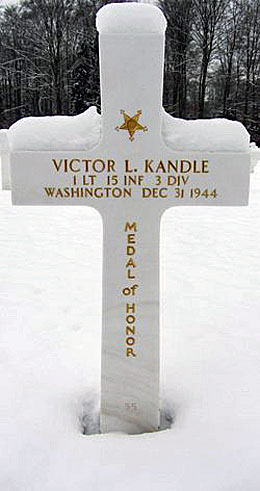On May 11, 1945, Victor L. Kandle (1921-1944), who was killed in action the previous New Year's Eve, is posthumously awarded the Medal of Honor for his heroism and contribution to the American advance at La Forge, France, in October 1944. Kandle was born and grew up in Pierce County, graduating from Puyallup High School. In 1940 he enlisted in the army as a private and trained at Fort Lewis, near the family homestead where he was born. After the United States entered World War II, Kandle completed officer candidate school, was commissioned as a lieutenant, and took part in the Allied invasion of southern France.
Victor Leonard Kandle
Victor Leonard Kandle, known as Leonard to his family, was born in 1921 on his grandmother's homestead near Roy, Pierce County. The homestead would become part of Fort Lewis in 1941. His parents, Clyde C. Kandle (1897-1980), an electrician, and Ilma Kandle (1900-1996), moved the family around the Puget Sound area. They first lived in McKenna, where Leonard attended McKenna Grade School. He went to Yelm High School for one year and then his father took a position with Puget Sound Power and Light and the family moved to Puyallup. Leonard graduated from Puyallup High School in 1939. The next year he enrolled at the Beutel Business College in Tacoma. Kandle was an excellent student who was very cautious and careful in his studies and life. Some days he had to walk the eight miles each way from the family's Puyallup home to Tacoma for classes.
Kandle enlisted in the army on September 4, 1940. Private Kandle had basic and advanced infantry training at Fort Lewis, and was assigned to the 1st Battalion, 15th Infantry Regiment. His company was short of administrative personnel, and with his Beutel Business College experience Kandle was soon doing paperwork. Major General Kenyon Joyce (1896-1951) needed a field secretary and selected Kandle. One time in the field with the general, as they were observing training on lands near Roy, Kandle recognized the area as his grandmother's homestead that the army had recently acquired.
In January 1942 Victor Kandle married Marigene Lee (b. 1923) of Tacoma. They had their wedding in Olympia. Several months later Kandle was among some 1,000 Fort Lewis troops transferred to Camp Rucker in Alabama. He applied for officer candidate school and was accepted. He completed officer candidate school at Fort Benning in Georgia.
Kandle was commissioned a second lieutenant on August 18, 1943. He was shipped overseas in late 1943. Second Lieutenant Kandle was assigned to his Fort Lewis unit, the 15th Regiment, 3rd Infantry Division, and took part in the invasion of southern France. At this time he was promoted to first lieutenant.
Heroism on Patrol
On October 9, 1944, near La Forge, France, First Lieutenant Kandle led a reconnaissance patrol of 16 soldiers and a light-machine-gun squad into enemy territory. Quickly they captured five German prisoners. Heading the patrol, Kandle came face to face with a German major. Both men fired, with Kandle hitting and killing the German. The patrol continued over mountainous terrain and in heavy fog to a well-fortified German position that had held up a battalion of infantry for two days.
Kandle rushed the position and fought his way into the stronghold, forcing the Germans to surrender. Continuing his assault, he attacked an enemy machine-gun position and destroyed it. Then he led his patrol in the destruction of another machine-gun emplacement. Not slowing down, he took his force to attack a house that two German officers and 30 enlisted men were using as a fortified position. Kandle had his men establish a perimeter line around the house. He then ran across open land in full view of the defenders in the house to its front door. He smashed through the door and due to his audacity got all 32 Germans to surrender.
Kandle's leadership of the reconnaissance patrol resulted in the capture or death of three enemy officers and 54 enlisted men. The patrol also destroyed three enemy positions that had halted a large force. A fellow 15th Regiment officer, Lieutenant (later Major General) Maurice Kendall (b. 1921), commented that Kandle, who was known as cautious, used surprise and action to achieve results, adding that while Kandle had a cautious demeanor he had a great ability to quickly carry out an audacious plan.
Late on the evening of December 31, 1944, Lieutenant Kandle was riding on the back of a tank into enemy territory. Just as the New Year arrived a German soldier threw a grenade onto the tank. The grenade hit Kandle and killed him. For his heroism and contribution to the American advance at La Forge in October 1944, Kandle was awarded the Medal of Honor posthumously on May 11, 1945. Victor L. Kandle was buried in the Epinal American Cemetery and Memorial in Epinal, France.
Remembering Victor Leonard Kandle
On June 4, 1945, in a ceremony at the Presidio of San Francisco, Major General Henry C. Pratt (1882-1966), commanding general of the Western Defense Command, presented the Medal of Honor that had been awarded to Victor Kandle. Marigene Kandle accepted the Medal. She brought their son Terry Kandle (b. 1943) to the ceremony. At the time Marigene was attending the University of California and Terry was living with his grandparents in Redwood City, California. Among the distinguished guests at the ceremony was California Governor Earl Warren (1891-1974).
The Army Reserve Center in Tacoma was dedicated on October 17, 1958, as the Lt. Victor L. Kandle Hall in honor of the Medal recipient. Attending the dedication were his parents, widow Marigene Dodd, son Terry, brother Gene A. Kandle (1919-2003), and sister Shirley Kandle Hornbeck (1929-2004). (There is also a Kandle Park in Tacoma, but it is named for a different Kandle, George B. Kandle [1851-1926], who was mayor of Tacoma from 1890 to 1892).

